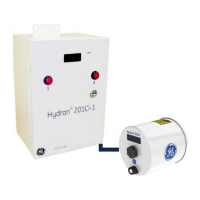- By verifying the status of the alarm contacts on the terminals 7 to 15 of
the Main Terminal Block (item 6 in Figure 4-6).
- By looking at the illuminated 1 (High alarm) and 2 (High-High alarm) push-
buttons on the enclosure door.
• H201Ci-C: No alarms.
Table 11-2 below lists the possible states of the alarm contacts.
Table 11-2: Possible States of the Alarm Contacts
11.2.3 Operation Modes of Alarm Relays
The mode of each alarm relay is set using the corresponding RelayMode parameter
in the Hydran 201Ti’s Relays/Analog submenu (or using the Hydran Host software).
There are four operation modes:
• Normal: See Section 1.1.1.1 below.
• Latch: See Section 1.1.1.2 below.
• Force OFF: See Section 1.1.1.3 below.
• Force ON: See Section 1.1.1.4 below.
The H201Ti’s three relays are independent. A relay can therefore be set to any
operation mode regardless of the mode of the two other relays.
1.1.1.1 Normal Mode
In this mode, the relay status changes if an alarm condition is detected during a
period of time exceeding the corresponding alarm delay; the relay returns to its former
status when the alarm condition disappears during a period of time exceeding the same
alarm delay. The Normal mode is the default setting.
In the Normal and Latch modes:
• The High and High-High alarm relays are energized when an alarm condition
is detected.
• The fail alarm relay, however, is de-energized when an alarm condition is
detected, to permit to detect a power failure (the relay’s power being
immediately off). This feature of the Hydran 201i System strengthens the
security of the alarm system. The fail alarm relay is thus energized (NO
contacts closed and NC contacts open) if no alarm condition is detected.

